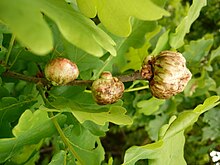Gallic acid
| Structural formula | |||||||||||||||||||
|---|---|---|---|---|---|---|---|---|---|---|---|---|---|---|---|---|---|---|---|

|
|||||||||||||||||||
| General | |||||||||||||||||||
| Surname | Gallic acid | ||||||||||||||||||
| other names |
|
||||||||||||||||||
| Molecular formula | C 7 H 6 O 5 | ||||||||||||||||||
| Brief description |
yellowish needles |
||||||||||||||||||
| External identifiers / databases | |||||||||||||||||||
|
|||||||||||||||||||
| properties | |||||||||||||||||||
| Molar mass | 170.12 g mol −1 | ||||||||||||||||||
| Physical state |
firmly |
||||||||||||||||||
| density |
1.69 g cm −3 |
||||||||||||||||||
| Melting point |
253 ° C (decomposition) |
||||||||||||||||||
| pK s value |
3.13 (COOH) |
||||||||||||||||||
| solubility |
|
||||||||||||||||||
| safety instructions | |||||||||||||||||||
|
|||||||||||||||||||
| Toxicological data | |||||||||||||||||||
| As far as possible and customary, SI units are used. Unless otherwise noted, the data given apply to standard conditions . | |||||||||||||||||||
Gallic acid (3,4,5-trihydroxybenzoic acid) is an aromatic compound that is derived from both benzoic acid and pyrogallol (1,2,3-trihydroxybenzene). The structure consists of a benzene ring with an attached carboxy group (-COOH) and three hydroxyl groups (-OH) as substituents . It belongs to the group of trihydroxybenzoic acids , their salts are called gallates .
history
Gallic acid was first described by Carl Wilhelm Scheele . As a natural product of the vegetable secondary metabolism , it is the most important original compound of the aromatic compounds in petroleum .
Occurrence
Gallic acid is the building block of the vegetable tannin group of gallotannins and comes e.g. B. very rich in oak bark and gall apples . Compared to black tea , green tea contains ten times the amount of gallic acid and twice as much gallic acid as oolong tea .
synthesis
In the industrial production of gallic acid, molds are mostly used, whereby the enzyme tannase is formed. Tannase breaks down tannins into gallic acid and sugar . Gallic acid can also be obtained from aqueous extracts of gall apples or by hydrolytic cleavage with dilute acids.
properties
When gallic acid is heated, carbon dioxide is split off ( decarboxylation ) and pyrogallol (1,2,3-trihydroxybenzene) is formed.
use
Gallic acid is used to make iron gall inks (formerly), antioxidants in food, sunscreens and dyes (e.g. anthracene brown , gallamine blue , gallocyanine , rufigallic acid ).
Individual evidence
- ↑ Entry on GALLIC ACID in the CosIng database of the EU Commission, accessed on May 13, 2020.
- ↑ a b Entry for CAS no. 149-91-7 in the GESTIS substance database of the IFA , accessed on January 6, 2008(JavaScript required) .
- ↑ a b c d Entry on gallic acid. In: Römpp Online . Georg Thieme Verlag, accessed on December 25, 2014.
- ↑ a b c d Entry on gallic acid in the ChemIDplus database of the United States National Library of Medicine (NLM) .
- ↑ a b data sheet Gallic acid from Sigma-Aldrich , accessed on April 2, 2011 ( PDF ).


